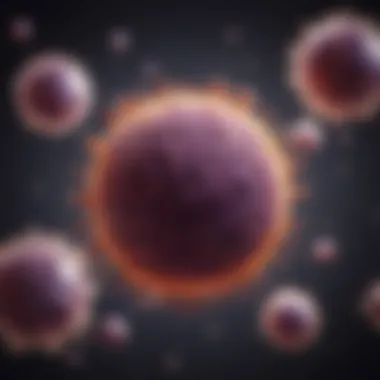Types of Pancreatic Cancer: A Comprehensive Exploration


Intro
Pancreatic cancer, often seen as a silent predator, continues to be one of the most aggressive forms of cancer, presenting significant challenges to both patients and healthcare providers alike. The unique characteristics of this disease can often lead to late-stage diagnosis, making it imperative to explore the various types present within this organ.
Understanding pancreatic cancer requires diving beyond the common narration, addressing the diverse forms this malignancy takes. There are primarily two categories of pancreatic tumors: exocrine and neuroendocrine. Both types exhibit distinct behaviors, origins, and clinical implications.
The exocrine tumors, which comprise the majority of pancreatic cancers, are primarily associated with ductal adenocarcinoma. This is a type of tumor that arises from the exocrine cells, which are responsible for producing digestive enzymes. On the other hand, neuroendocrine tumors arise from hormone-producing cells within the pancreas, and while they are less common, their clinical management and prognostic outcomes can vary widely.
A closer examination into the histological types, staging systems, and diagnostic approaches showcases the urgent need for awareness and screening methods that could lead to earlier detection. With the right strategies, the treatment options tailored for these specific types can greatly improve patient outcomes, making it essential to keep abreast of the latest research and clinical practices relevant to pancreatic cancer.
Throughout this exploration, we will emphasize the intricacies of pancreatic cancer, from its diverse types to the significance of a personalized therapeutic approach.
"Understanding the specific type and characteristics of pancreatic cancer is crucial in managing the disease effectively. Every detail counts, from histological classifications to staging systems."
This comprehensive overview aims to furnish researchers, educators, and healthcare professionals with a solid foundation of knowledge, paving the way for informed discussions and advanced research in this critical field of oncology.
Preamble to Pancreatic Cancer
Exploring pancreatic cancer is crucial due to its notorious reputation as one of the deadliest malignancies. This cancer type often flies under the radar until it reaches an advanced stage, making early detection a significant challenge. Understanding the nuances of this disease not only helps in recognizing symptoms but also paves the way for potential treatments and better outcomes. By dissecting the various types of pancreatic cancer, including their characteristics and cause, we shed light on how vital awareness and research can be in battling this malignancy.
Understanding the Pancreas
The pancreas is a small but mighty organ nestled behind the stomach. Its role is multifaceted. Not only does it produce digestive enzymes that are crucial for breaking down food, but it also plays a pivotal role in regulating blood sugar levels by secreting hormones like insulin. Given its function, any disruption in pancreatic health can have wide-reaching effects on digestion and metabolism.
In the anatomy of the pancreas, we find two main areas: the exocrine and endocrine tissues. The exocrine part is responsible for producing enzymes that aid in digestion, while the endocrine tissue releases hormones directly into the bloodstream. This distinction is essential because it lays the groundwork for understanding the different types of tumors that can emerge within the organ.
Incidence and Significance
Pancreatic cancer, though less common than some other cancers, presents a stark reality with alarming statistics. According to various cancer registries, the incidence rates continue to rise, positioning this malignancy as a growing public health concern. The American Cancer Society indicates that about 60,000 new cases are diagnosed annually in the United States alone.
"Pancreatic cancer is often termed a 'silent killer' due to its vague symptoms and late detection, leading to a five-year survival rate of merely 10%."
The significance of understanding pancreatic cancer cannot be understated. Individuals often ignore early signs, mistaking them for ordinary digestive issues or stress. This lack of recognition can delay diagnosis and treatment, highlighting the necessity for education and awareness campaigns.
- Key statistics include:
- Rising incidence rates, particularly among older adults.
- Low survival rates, with a five-year survival rate of around 10%.
- Increasing prevalence prompts the need for comprehensive research into effective treatment strategies.
By delving deeper into pancreatic cancer's types, we open doors to the prospect of earlier detection and more personalized treatments, ultimately contributing to better outcomes for patients.
Classification of Pancreatic Cancer
Understanding the classification of pancreatic cancer is crucial to grasping how this disease manifests and affects patients. The types of pancreatic cancer are broadly divided into exocrine and neuroendocrine tumors, which have distinct characteristics, behaviors, and treatment protocols. In doing so, researchers and clinicians can improve diagnostic accuracy, tailor treatment approaches, and enhance patient outcomes. This classification not only informs clinical practice but also guides ongoing research into more effective therapeutic strategies.
Exocrine Pancreatic Tumors
Exocrine pancreatic tumors represent the majority of pancreatic cancers, accounting for about 95% of cases. The most prevalent of these is pancreatic adenocarcinoma, which often originates in the ducts of the pancreas. This type of cancer is notorious for its late diagnosis and dismal prognosis, primarily due to the asymptomatic nature of the early stages.
Here's a breakdown of the main features of exocrine tumors:
- Adenocarcinoma of the Pancreas: Characterized by aggressive growth and typically diagnosed in advanced stages. Risk factors include smoking, obesity, family history, and age.
- Cystic Neoplasms: These can be further divided into mucinous cystic neoplasms and intraductal papillary mucinous neoplasms, often presenting as fluid-filled sacs in the pancreas. These tumors may have a better prognosis than adenocarcinoma, especially if managed appropriately.
- Acinar Cell Carcinoma: A rarer subset of exocrine tumors, acinar cell carcinoma often produces digestive enzymes and can be challenging to diagnose due to its atypical presentation.
- Other Exocrine Tumors: This includes less common tumors such as solid pseudopapillary neoplasm and pancreatoblastoma, the latter generally occurring in children.
Understanding these tumors helps in identifying symptomatic patients early on, which may lead to timely interventions that could significantly impact survival rates.
Neuroendocrine Tumors
Neuroendocrine tumors of the pancreas are less common but can exhibit distinct behavior that may make them more treatable in some instances. These tumors arise from the hormone-producing cells of the pancreas, including insulin-producing and glucagon-producing cells.
Key types of neuroendocrine tumors include:
- Insulinomas: Generally benign, insulinomas secrete insulin and can lead to symptoms of hypoglycemia. Early diagnosis is vital for effective management.
- Gastrinomas: These tumors produce excess gastrin, which can cause Zollinger-Ellison syndrome, leading to recurrent gastric ulcers. Treatment may involve surgical intervention or medication.
- VIPomas: These tumors secrete vasoactive intestinal peptide, leading to severe diarrhea and electrolyte imbalances. They present unique challenges in diagnosis and management.
- Glucagonomas: Glucagon-secreting tumors can lead to a range of symptoms, including a distinctive rash known as necrolytic migratory erythema. They are usually aggressive, and comprehensive management is often required.
This delineation of neuroendocrine tumors underscores the importance of recognizing their unique characteristics and treatment avenues, distinct from the exocrine tumors.
By classifying pancreatic cancer types, healthcare professionals can better tailor management strategies to individual cases, ultimately enhancing the quality of care.
Getting a clear picture of these classifications allows for improved understanding, research development, and patient awareness, thereby fostering enlightenment around a disease often shrouded in complexity. It is only through understanding these classifications that one could hope to unravel the mysteries that pancreatic cancer presents.
Exocrine Pancreatic Tumors
Exocrine pancreatic tumors are pivotal in understanding pancreatic cancer as a whole, accounting for the vast majority of cases diagnosed. These tumors arise from the exocrine cells of the pancreas, which are responsible for producing digestive enzymes. Given the high prevalence of these tumors, knowing their characteristics and nuances is essential for early detection, treatment options, and prognostic assessments. Different types of exocrine tumors present unique features and risk profiles that deserve thorough analysis.
Adenocarcinoma of the Pancreas
Pathophysiology
The pathophysiology of pancreatic adenocarcinoma is complex, marked by a series of genetic mutations that lead to uncontrolled cell growth. Notably, mutations in the KRAS gene occur in over 90% of cases, serving as a hallmark of this cancer type. This specific characteristic elucidates the fundamental alteration in cellular signaling that drives tumorigenesis. Understanding these mechanisms helps illuminate potential therapeutic targets that could disrupt these malignant processes.
Risk Factors
Risk factors for pancreatic adenocarcinoma include a mix of genetic, environmental, and lifestyle elements. Key contributors include smoking, obesity, and age, alongside familial history of pancreatic cancer. These factors collectively enhance the understanding of who might be at increased risk, making early screening more crucial. Each risk factor also carries unique implications, such as the potential for preventive measures in susceptible populations.
Symptoms and Diagnosis
Symptoms of pancreatic adenocarcinoma can be quite vague, often presenting only at advanced stages. Jaundice, unexplained weight loss, and abdominal pain are often the top complaints. Because these symptoms can mimic a variety of other conditions, accurate diagnosis frequently hinges on advanced imaging techniques like CT scans or MRI. Recognizing the constellation of symptoms early provides a better chance for intervention, emphasizing the importance of awareness in both patients and healthcare providers.


Staging and Prognosis
Staging of pancreatic adenocarcinoma follows the AJCC staging system, which plays a crucial role in determining treatment approaches. The unique feature of this staging system is its stratification based on tumor size, lymph node involvement, and the presence of metastasis. Each stage correlates closely with prognosis, revealing stark differences in survival rates. Early detection leads to more favorable outcomes, hence the ongoing emphasis on research into earlier diagnostic methods.
Cystic Neoplasms
Mucinous Cystic Neoplasm
Mucinous cystic neoplasms are notable for their distinct histological characteristics and clinical behavior. Typically seen in females, these tumors are known for their potential to become malignant. The unique feature of mucinous cystic neoplasms is their mucin production, which can be indicative of more favorable outcomes when diagnosed early. Understanding this aspect can lead to informed clinical decisions regarding surveillance and treatment protocols.
Intraductal Papillary Mucinous Neoplasm
Intraductal papillary mucinous neoplasms (IPMNs) are precursors to pancreatic cancer and represent an essential part of the diagnostic landscape. They arise within the pancreatic duct and lead to mucin secretion, often creating cystic lesions. Their key characteristic lies in their variable potential for malignant transformation, making proper diagnosis and continued monitoring paramount. Understanding IPMNs' pathways to malignancy can enhance prevention strategies and optimize clinical management approaches.
Acinar Cell Carcinoma
Characteristics
Acinar cell carcinoma stands apart from more common pancreatic tumors due to its unique origin from acinar cells which produce digestive enzymes. These tumors are rare but exhibit distinct biological features. Specifically, they often produce enzymes like lipase, reflecting their acinar lineage. Recognizing this helps clinicians tailor treatment strategies accordingly, providing a nuanced approach to therapy that considers each tumor's specific origins and characteristics.
Clinical Presentation
Clinically, acinar cell carcinoma may present with symptoms akin to those of adenocarcinoma, yet more pronounced abdominal pain and jaundice can be observed. This overlap complicates diagnosis and underscores the importance of thorough evaluation. The rarity of the tumor type, combined with its similar presentation to more prevalent forms, creates challenges in achieving timely, accurate diagnosis.
Other Exocrine Tumors
Solid Pseudopapillary Neoplasm
Solid pseudopapillary neoplasm, often found in young females, is characterized by its low-grade malignancy and unique histology. Clinicians value the unique aspects of this tumor because it often has a favorable prognosis post-surgery. Understanding the biology and typical presentation of this tumor aids in distinguishing it from more aggressive forms and fosters appropriate management strategies.
Pancreatoblastoma
Pancreatoblastoma is primarily a pediatric tumor, which, although rare, is notable for its unique features and clinical behavior. The conditions seen in this tumor type highlight the importance of differential diagnosis in children. Its rarity and distinct histological characteristics provide an essential discussion point in an article focused on pancreatic tumors, emphasizing the necessity for awareness in both pediatric and adult oncology settings. With age and tumor type having significant implications on treatment and prognosis, understanding this neoplasm lays a groundwork for further research and clinical advancements.
Neuroendocrine Tumors of the Pancreas
Neuroendocrine tumors (NETs) of the pancreas are a specialized group of neoplasms that arise from hormone-producing cells within the pancreas. This segment focuses on the uniqueness of neuroendocrine tumors, revealing their less common yet significant role in pancreatic cancer. Unlike the more prevalent exocrine tumors, NETs often have distinct clinical presentations and can behave differently in terms of growth and metastasis. Understanding these tumors is crucial as they offer diverse treatment opportunities and have a wide range of prognostic outcomes.
Insulinomas
Overview
Insulinomas are a type of neuroendocrine tumor that primarily secretes insulin, leading to hypoglycemia. They are notable for their small size, often found as solitary lesions, and can be challenging to detect due to their high variability in presentation. Their main hallmark is the overproduction of insulin, which can cause low blood sugar levels, sometimes resulting in life-threatening complications. In terms of rarity, insulinomas comprise about 10-20% of all NETs, which brings a unique perspective to our understanding of pancreatic malignancies. Notably, they present unique characteristics, such as a propensity for benign behavior, making surgical resection a favorable option that can lead to potential cure.
Diagnosis and Management
Diagnosing insulinomas typically involves assessing blood glucose levels, insulin levels, and often, during episodes of hypoglycemia, the measurement of C-peptide levels. The management of insulinoma primarily revolves around surgical intervention, ideally when the tumor is localized. The unique feature of this diagnosis is that while lesions can be benign, their functional activity requires swift intervention to manage the hypoglycemic episodes effectively. Additionally, medication can aid in symptom management, especially when surgery is not an option. This balance between surgical and conservative management is critical in enhancing patient outcomes and quality of life.
Gastrinomas
Clinical Features
Gastrinomas, or Zollinger-Ellison syndrome, results from gastrin-secreting tumors that lead to excessive gastric acid production, causing recurrent peptic ulcer disease. Their primary characteristic is the gastric acid hypersecretion, leading to various gastrointestinal complications. This aspect is crucial because differentiating gastrinomas from other ulcerogenic conditions can significantly impact treatment decisions. Gastrinomas can occur sporadically or as part of multiple endocrine neoplasia type 1 (MEN1). Understanding these clinical features helps in early identification and tailored management strategies.
Treatment Options
Treatment options for gastrinomas include surgical resection, which remains a cornerstone if localized, and the use of proton pump inhibitors for symptom relief from acid overproduction. Further, in cases where surgery is not feasible, somatostatin analogs can help control excess acid production. The key characteristic of this treatment spectrum is its balancing act: while surgery offers long-term remission potential, medical management plays an important role in short-term symptom relief. Thus, effective management hinges on a multidisciplinary approach to provide comprehensive care for patients.
VIPomas
Pathophysiology
VIPomas are rare neuroendocrine tumors that secrete vasoactive intestinal peptide (VIP), leading to a unique clinical scenario marked by profuse watery diarrhea—often termed WDHA syndrome (Watery Diarrhea, Hypokalemia, Achlorhydria). The pathophysiology underlying VIPomas involves the overproduction of VIP, disrupting normal electrolyte and fluid balance. Their distinct feature lies in the severe secretory diarrhea, which can lead to substantial dehydration and metabolic disruptions.
Symptoms and Diagnosis
Symptoms of VIPomas include copious diarrhea, dehydration, and electrolyte imbalances, particularly hypokalemia. Their diagnosis often involves measuring VIP levels in the blood alongside imaging studies to locate the tumor. The unique feature here is that many patients may present with severe symptoms that prompt early medical intervention, leading to quicker diagnosis. However, the symptomatology can often mimic other conditions, complicating the diagnostic process. Such complexities necessitate astute clinical acumen and comprehensive investigative measures.
Glucagonomas
Characteristics
Glucagonomas are lesser-known NETs, characterized by excessive glucagon production, resulting in hyperglycemia and a characteristic rash known as necrolytic migratory erythema. This rarity and symptomatology highlight important aspects of these tumors, including their potential for early diagnosis if symptoms are recognized. The increasing awareness of glucagonomas in the context of unexplained weight loss and hyperglycemia is essential, as it can expedite therapeutic interventions that significantly improve patient outcomes.
Management Strategies
Managing glucagonomas often involves surgical resection if the tumor is localized. Symptomatic treatment usually entails controlling hyperglycemia and managing skin rashes with topical therapies. This multifaceted approach ensures a balance between addressing the underlying tumor and managing the symptomatic disease. The unique aspect of glucagonomas, as with many NETs, is the need for a nuanced understanding of the tumor behavior and related symptoms, paving the way for improved therapeutic strategies.
"Understanding the range of pancreatic neoplasms, including neuroendocrine tumors, provides a more comprehensive picture of pancreatic cancer, ultimately enhancing therapeutic outcomes and patient management strategies.”
Through this examination of neuroendocrine tumors, further insights into patient treatments and outcomes can be gained, emphasizing the need for personalized therapeutic regimens.
Diagnosis of Pancreatic Cancer
Diagnosing pancreatic cancer is a pivotal step in the trajectory of the disease, one that can significantly affect outcomes and treatment options. Early detection remains a cornerstone of effective management in oncology. The pancreas, located deep within the abdomen, isn't easily assessable through mere physical examination. Therefore, precise diagnostic methods are crucial for ensuring that this malignancy is identified as early as possible to improve survival chances.


There are various approaches to diagnosing pancreatic cancer, each with unique strengths and weaknesses. These methods help in determining the presence of cancer, understanding its type, and assessing the stage of the disease. In particular, imaging techniques and biopsy methods stand out as integral components of the diagnostic process.
Imaging Techniques
CT Scans
CT scans, or computed tomography scans, provide detailed cross-sectional images of the body, enabling healthcare providers to visualize the pancreas and surrounding structures clearly. This imaging technique is often the first line of defense in diagnosing pancreatic cancer.
Key characteristics include its speed and widely available nature, making it a popular choice for initial assessments. One unique feature of CT scans is their ability to provide three-dimensional images of the abdomen, which helps identify lesions that may be too small to detect by other means. However, they do expose the patient to some level of radiation, which is a consideration in terms of patient safety and long-term health.
MRIs
Magnetic Resonance Imaging (MRI) serves as another valuable imaging tool in the diagnostic arsenal. Unlike CT scans, MRIs use magnetic fields and radio waves to generate images, making them excellent for differentiating between various types of soft tissues.
This imaging technique is particularly beneficial in assessing the extent of the tumor as well as detecting additional lesions. Its key characteristic lies in its no ionizing radiation, making it safer for repeated use. Nonetheless, MRIs can take longer than CT scans and may not always be available in emergency settings, limiting its use in urgent situations.
Endoscopic Ultrasound
Endoscopic Ultrasound (EUS) represents an advanced, minimally invasive technique that allows for direct visualization of the pancreas and surrounding structures via an endoscope. This method has gained traction due to its high sensitivity in detecting small tumors.
What makes EUS unique is its ability to combine imaging with the potential for tissue sampling. With it, doctors can conduct fine needle aspirations on suspicious lesions right at the time of imaging. However, the technique does require specialized training and is not available everywhere, which can be a limitation in certain clinical settings.
Biopsy Methods
Biopsy methods are crucial for confirming a diagnosis when imaging results show suspicious areas. They involve extracting small amounts of tissue for pathological examination, ensuring that treatment decisions are based on precise information.
Fine Needle Aspiration
Fine Needle Aspiration (FNA) is commonly used due to its simplicity and effectiveness. The procedure involves inserting a thin needle into the pancreas to extract a tissue sample. FNA has a key characteristic of being minimally invasive, providing quick results with less discomfort to the patient.
The unique feature of FNA is its ability to be performed in conjunction with imaging techniques, such as ultrasound or CT scans, allowing for real-time guidance. Nonetheless, while FNA is effective, it may sometimes yield insufficient material for a definitive diagnosis, necessitating further procedures.
Core Needle Biopsy
Core Needle Biopsy offers a slightly different approach by removing a larger tissue sample than FNA. The larger sample can provide more comprehensive information about tumor characteristics. This method is beneficial when the finer needle may not capture the entire picture of the lesion.
Its key characteristic is the ability to obtain a more substantial tissue sample, which can be crucial for accurate classification and treatment planning. However, it can come with increased discomfort and a higher risk of complications, albeit small. Despite this, the benefit of obtaining adequate tissue for diagnosis often outweighs the risks involved.
Timely and accurate diagnosis of pancreatic cancer significantly enhances the chances of successful treatment, underlining the importance of employing appropriate imaging and biopsy techniques.
Staging of Pancreatic Cancer
Staging of pancreatic cancer is a critical aspect of understanding the disease's progression and determining the most effective treatment strategies. Without a clear grasp of the stage at which a patient has been diagnosed, it can be challenging for healthcare providers to plan a suitable therapeutic approach. Each stage provides insights into tumor size, the extent of spread to nearby tissues, and possible metastasis to other organs. In essence, the stage not only influences prognosis but also dictates the urgency and type of interventions required.
One of the key benefits of staging is that it allows for a more customized treatment plan tailored to the individual patient. For instance, two patients with pancreatic cancer might be diagnosed with differing treatments based on their cancer's staging, demonstrating how critical this classification is for personalized care. In addition, understanding the stage can help in counseling patients regarding their prognosis and potential outcomes, fostering better communication between healthcare providers and patients.
AJCC Staging System
The AJCC (American Joint Committee on Cancer) Staging System is widely recognized for its comprehensive approach to cancer classification, and pancreatic cancer is no exception. This system employs a combination of tumor size (T), lymph node involvement (N), and the presence of metastasis (M) to categorize cancer into distinct stages.
- T (Tumor Size and Local Extent): This indicates how large the tumor is and whether it has invaded nearby structures. The numbers run from T1 to T4, with higher numbers indicating larger tumors and greater invasiveness.
- N (Regional Lymph Nodes Involvement): This assesses whether the cancer has spread to nearby lymph nodes. N0 indicates no involvement while N1 signifies involvement of nearby lymph nodes.
- M (Distant Metastasis): This is critical for understanding if the cancer has spread to distant organs. M0 indicates no distant metastasis and M1 indicates the presence of such spread.
The combination of these factors results in a stage classification ranging from Stage 0 (localized) to Stage IV (advanced, with distant metastases). For example, a tumor classified as T2 N1 M0 would mean a locally advanced tumor that has spread to nearby nodes but not distantly.
Understanding the AJCC Staging System is crucial, as it lays the groundwork for treatment decisions and expected outcomes. Healthcare professionals rely on this system to identify candidates for surgical resection, chemotherapy protocols, and even eligibility for clinical trials.
Implications for Treatment
The stage of pancreatic cancer has profound implications for treatment decisions. For early-stage disease (Stage I and II), surgical options might provide a chance for cure through procedures like the Whipple operation. The feasibility of surgery often diminishes with advancing stages, particularly when metastases are involved, rendering curative intentions less realistic.
- Surgical Treatment:
- Chemotherapy and Radiation:
- Targeted Therapy and Immunotherapy:
- It is primarily considered in earlier stages.
- Success depends on the ability to achieve negative margins during resection.
- Typically integrated in higher-stage cases.
- Neoadjuvant therapy may be considered to shrink tumors before surgery, while adjuvant therapy may help eliminate residual disease post-surgery.
- Emerging options tailored for specific genetic markers in advanced cases, particularly in those who meet eligibility criteria for clinical trials.
As the correlation between staging and treatment options is significant, understanding each stage enables oncologists to better navigate the complexities of treating this formidable disease. Patients are encouraged to engage in shared decision-making with their healthcare teams to explore all treatment avenues, considering their unique situation, health status, and preferences.
"The importance of early detection and accurate staging in pancreatic cancer cannot be overstated. It truly alters the landscape of treatment options available."
Treatment Options for Pancreatic Cancer
Treating pancreatic cancer presents a labyrinth of choices and strategies. The overall aim is to defeat this insidious disease while achieving the best possible quality of life for patients. Understanding the diverse treatment options is critical, as they offer various pathways tailored to individual cases. This can encompass a combination of surgical interventions, chemotherapy, radiation therapy, and targeted therapies. Each of these approaches plays a specific role, depending on factors such as the tumor type, stage, and the patient’s overall health.
Surgical Approaches
Whipple Procedure
One of the most significant surgical interventions for pancreatic cancer is the Whipple procedure, also known as pancreaticoduodenectomy. This operation involves the removal of the head of the pancreas, part of the small intestine, bile duct, and sometimes a portion of the stomach. The appeal of the Whipple procedure lies in its potential for curative outcomes, particularly in early-stage adenocarcinoma.
The key characteristic of this procedure is its complexity; it’s seen as one of the most demanding surgeries in oncology. Why is it so popular? Well, it offers a chance at long-term survival for patients who meet the necessary criteria. However, it is not without risks—complications can occur, and recovery can be arduous.
A unique feature of the Whipple procedure is the extensive reconstruction needed afterward, which can lead to long-term digestive changes. These can range from losing weight to facing challenges with insulin management. Yet, many patients opt for this bold path, driven by the hope of halting the disease.


Distal Pancreatectomy
Distal pancreatectomy involves the removal of the body and tail of the pancreas, often done in cases of tumors located in those regions. This surgery is particularly beneficial for patients with specific types of tumors, including certain neuroendocrine cancers. The major charm of this approach is that it’s less extensive than the Whipple procedure, translating into potentially shorter recovery times.
The key characteristic of the distal pancreatectomy is its focus on preserving as much pancreatic tissue as possible when feasible. This can be a stronger choice for those aiming to maintain normal digestive function and metabolic health. Nevertheless, like anything, it’s a double-edged sword: while preserving tissue can be advantageous, it does not provide a radical cure for all cases and may require continuous monitoring post-surgery for any recurrence.
Chemotherapy
Chemotherapy is an integral part of managing pancreatic cancer, both to shrink tumors before surgery (neoadjuvant) and to eliminate lingering cancer cells after surgery (adjuvant). This comprehensive approach aims to enhance the overall outcomes by facing the disease from multiple angles.
Adjuvant Chemotherapy
Adjuvant chemotherapy is administered following surgery. Its role is to ensure that any microscopic disease left behind is effectively targeted. This treatment can take several forms, often utilizing a combination of drugs to attack cancer cells from different fronts. The notable aspect here is how it can significantly improve long-term survival rates for patients who have had surgery.
What makes adjuvant therapy particularly popular is its ability to reduce recurrence, helping patients to feel a sense of security through the process. However, it’s not without downsides: patients might experience side effects ranging from nausea to fatigue, sometimes impacting their quality of life.
Neoadjuvant Chemotherapy
Neoadjuvant chemotherapy, on the other hand, is given before surgical intervention. It helps to reduce the tumor size, making it easier to remove during surgery. This proactive approach can also help in assessing how the cancer responds to treatment, providing valuable insights into its aggressiveness.
The appeal of neoadjuvant chemotherapy is clear; it can turn a challenging surgical case into a more manageable one. Yet it carries its own weight of side effects, and not every patient responds positively, which can lead to uncertain outcomes.
Radiation Therapy
Radiation therapy can also be a cornerstone of treatment for pancreas cancer, particularly in managing pain and treating localized disease. Its role can be two-fold: it may be used either as a primary treatment in cases where surgery is not an option or as an adjuvant therapy combined with chemotherapy and surgery. The unique aspect lies in its ability to target the tumor specifically, sparing surrounding healthy tissue where possible.
Targeted Therapies
Targeted therapies represent the cutting-edge frontier in cancer treatment. They work by focusing on specific molecular targets associated with cancer cells. This form of treatment can be particularly beneficial for patients whose tumors harbor certain genetic mutations that can be exploited.
Clinical Trials
Clinical trials are essential to advancing medical knowledge. They offer patients access to groundbreaking therapies that might not yet be widely available. Enrolling in a trial can provide an opportunity to receive state-of-the-art treatment, often with close monitoring and additional support. These trials often assess new drugs, combinations, and methods that might revolutionize treatment approaches in the near future. However, they also come with uncertainties and the possibility that treatment might not be effective.
Emerging Therapies
Emerging therapies, including immunotherapies and gene therapies, hold promise in changing the landscape of treatment for pancreatic cancer. They focus on harnessing the body’s immune system or altering genetic components to defeat cancer. While they are still under investigation, their potential to offer personalized treatment options is substantial. There’s a caveat, though—these therapies come with unpredictability and require extensive research to establish efficacy fully.
Understanding the treatment options available for pancreatic cancer is vital, as careful consideration of individual patient profiles greatly influences survival outcomes. This intricate network of choices reflects the evolving nature of oncology, emphasizing the need for a nuanced approach to care.
Prognosis and Survival Rates
Understanding the prognosis and survival rates for pancreatic cancer is of paramount importance. It shapes the clinical approach to treatment, guides patient and family decision-making, and fosters a deeper understanding of the long-term outcomes. When discussing pancreatic cancer, one cannot overlook its reputation as one of the deadliest cancers, partly due to the late-stage diagnosis that many patients face. Therefore, knowledge about prognosis informs both healthcare professionals and patients about the journey ahead and options for care.
Prognosis involves predicting the likely course of the disease and the chances of recovery. Survival rates are statistical estimates that represent the percentage of patients who survive a certain amount of time after diagnosis. When exploring prognosis related to pancreatic cancer, key elements come into play:
- Type of Tumor: As mentioned previously in the article, exocrine tumors, particularly adenocarcinomas, present poorer outcomes compared to neuroendocrine tumors, which generally have a more favorable prognosis.
- Staging at Diagnosis: The stage of cancer at the time of diagnosis dramatically influences prognosis. Catching it at stage I or II can dramatically improve survival chances over late-stage diagnoses, where the disease has often spread.
- Patient Health and Age: An individual’s overall health, age, and existing medical conditions can also play significant roles. Younger patients generally have better survival odds and can often tolerate aggressive treatment better.
This multifaceted nature of prognosis helps healthcare providers tailor treatment strategies to individual patients, weighing risks and benefits accordingly.
Factors Influencing Prognosis
Several factors intricately weave into the prognosis for pancreatic cancer:
- Tumor Location: Tumors located in the head of the pancreas tend to cause more obstructive symptoms, typically leading to earlier diagnoses. In contrast, lesions in the tail or body may remain unnoticed until later stages.
- Histological Features: The microscopic characteristics of the tumor, including differentiation, can provide insight. Well-differentiated tumors tend to respond better to treatment compared to poorly differentiated ones.
- Molecular Markers: Recent research is shedding light on biomarkers such as BRCA mutations, which might offer specific treatment options and also reflect prognosis. This genetic insight can sometimes provide a glimmer of hope and an avenue for personalized therapy.
- Response to Treatment: How well a patient responds to initial treatments, including surgery or chemotherapy, can significantly alter prognosis. Patients showing a strong response might yield better long-term outcomes.
Understanding these variables allows for a more nuanced view of each individual case, fostering hope but also realism.
Survival Rate Statistics
Survival statistics, commonly referenced by the five-year survival rate, offer a gauge for the expected outcomes for pancreatic cancer patients. However, these figures often come with caveats due to the disease's complexity:
- Overall Survival Rate: The five-year survival rate for pancreatic cancer is approximately 10%. But, this doesn't tell the whole story as survival rates can be misleadingly uniform.
- Localized Disease: For patients diagnosed with localized disease, the five-year survival rate jumps to about 39%. This statistic emphasizes the critical need for earlier detection as it can substantially change the patient’s outcome.
- Regional Disease: When the cancer spreads to nearby tissues, the survival rate drops to roughly 13%. Once again, this underscores the need for comprehensive screenings and awareness.
- Distant Metastasis: Once the cancer has metastasized to distant organs, such as the liver or lungs, the five-year survival rate plummets to around 3%. This statistic highlights the urgency of aggressive early intervention.
"The journey of a thousand miles begins with a single step." - This quote holds especially true for pancreatic cancer; early steps in diagnosis and treatment can lead to vastly improved patient outcomes.
In summary, while the statistics may seem disheartening, they also serve as critical reminders of the need for diligence in monitoring and studying this challenging disease. They encourage ongoing research efforts and interventions aimed at improving early detection and developing more effective treatment modalities.
Ending
The culmination of our exploration into pancreatic cancer reveals a landscape fraught with complexity and nuance. Understanding the types of pancreatic cancer is not just an academic exercise; it's a matter of clinical significance that directly impacts patient care and outcomes. This article highlights the necessity of recognizing the distinct characteristics of both exocrine and neuroendocrine tumors. In doing so, we underscore how vital precise classification is for effective treatment strategies.
Patients diagnosed with pancreatic cancer can benefit immensely from tailored approaches that consider the specific type of tumor present. This contributes directly to enhancing treatment efficacy and potentially improving survival rates. Furthermore, as we face the realities of this malignancy, the importance of early detection cannot be overstated. As the saying goes, "an ounce of prevention is worth a pound of cure." With earlier interventions, we might tilt the odds favorably for those affected.
In the realm of oncology, the insights gained from distinguishing between the myriad types of pancreatic cancer influence not just individual cases but also the trajectory of research efforts and funding allocations. The potential for breakthroughs in targeted therapies and personalized medicine hinges on refined understandings of tumor biology and pathophysiology.
Future Directions in Research
Research into pancreatic cancer is an ever-evolving field. Moving forward, several paths present themselves as critical areas for focus:
- Genetic and Molecular Profiling: Identifying specific biomarkers can pave the way for more personalized treatment options, enhancing the precision of therapeutic approaches.
- Early Detection Methods: Developing novel imaging techniques or biomarker tests that can detect pancreatic cancer at earlier stages remains an urgent endeavor.
- Immunotherapy: Exploring how the immune system can be harnessed to effectively combat cancer may yield exciting new treatments.
- Combination Therapies: Ongoing studies are examining the benefits of integrating various treatment modalities, including chemotherapy, radiation, and targeted therapies, to maximize patient outcomes.
As these areas are studied, potential collaborations between academia, industry, and patient advocacy groups will be essential in driving progress, thus improving the landscape for patients facing this formidable disease.
Final Thoughts
In summary, the journey through the types of pancreatic cancer illuminates significant insights for students, researchers, and healthcare professionals alike. It serves as a reminder of the intricate interplay between diagnosis, classification, and treatment. While pancreatic cancer presents challenges, our commitment to understanding it better can lead to notable advancements in how we treat and manage this illness. In facing one of the most daunting malignancies, our knowledge can serve as a beacon, guiding efforts toward improved patient care and hopeful outcomes.
"Knowledge is power. Information is liberating. Education is the premise of progress, in every society, in every family." — Kofi Annan
In this context, every step taken in research and clinical practice shapes a broader narrative. It advocates for the need to advance understanding, decrease stigma surrounding diagnosis, and foster a discourse that emphasizes hope and innovation.















